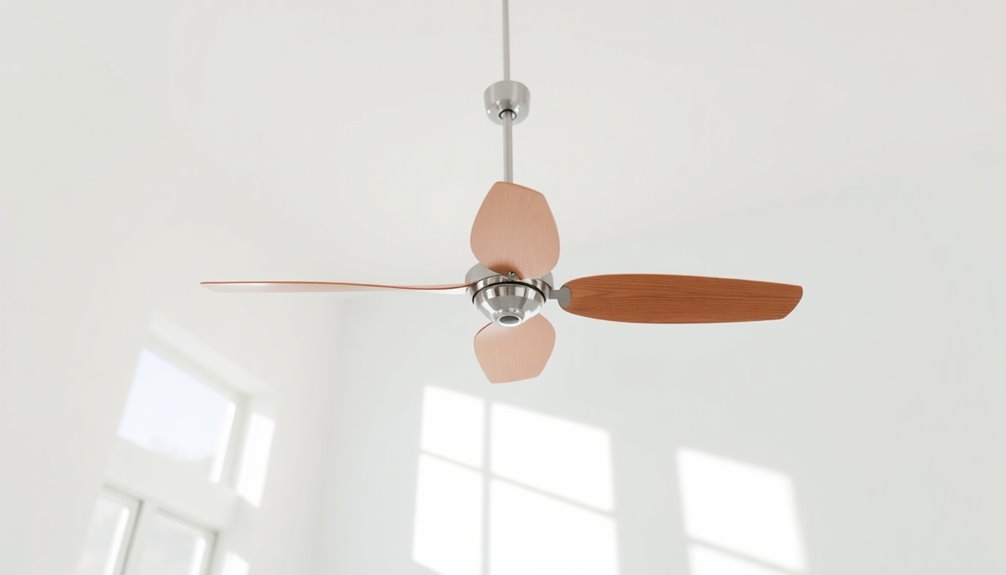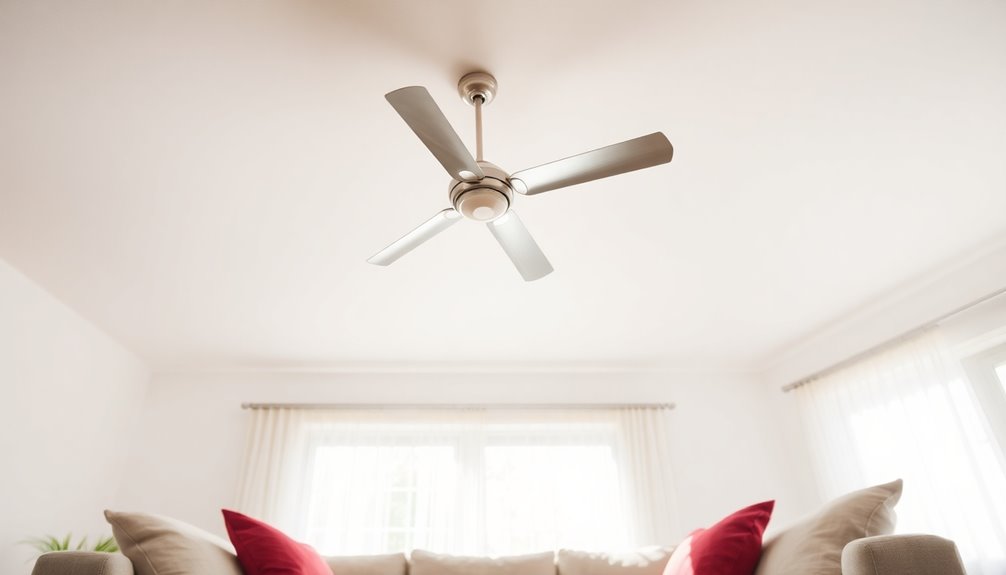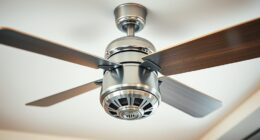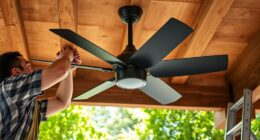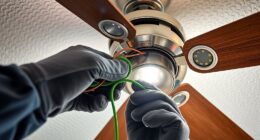Ceiling fans have a reverse function that lets you optimize air circulation year-round. In summer, the fan spins counterclockwise to push cool air down, creating a rejuvenating breeze. In winter, a clockwise rotation redistributes warm air, helping eliminate cold spots and allowing for lower thermostat settings. This seasonal adjustment can reduce heating costs by up to 10%, particularly in spaces with high ceilings. By using the reverse function, you enhance comfort while lowering energy expenses. Curious about how to maintain your fan for top performance? You might find some practical tips just around the corner!
Key Takeaways
- Ceiling fans have a reverse function to optimize air circulation for both heating and cooling throughout the year.
- In winter, clockwise rotation redistributes warm air, reducing heating costs by up to 10%.
- In summer, counterclockwise rotation creates a cooling breeze, enhancing comfort and preventing warm air stagnation.
- The reverse function helps eliminate temperature stratification, leading to a more consistent room temperature.
- Utilizing the reverse function alongside proper maintenance improves energy efficiency and indoor air quality.
Purpose of the Reverse Function
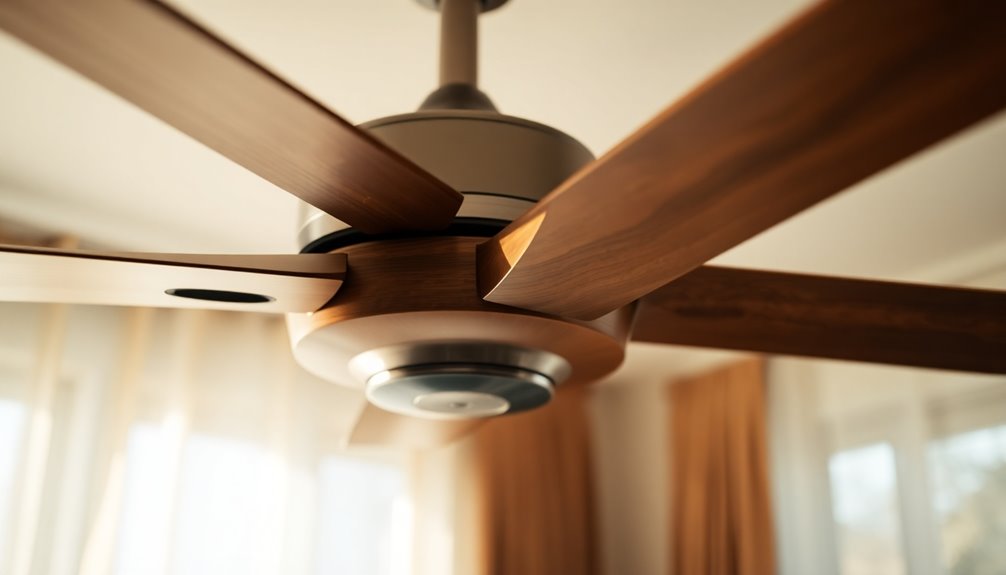
The reverse function on ceiling fans serves an essential purpose: it allows you to optimize air circulation throughout the year. By enabling you to change the direction of the blades, you can enhance both heating and cooling effects in your space.
In the summer, running the fan counterclockwise creates a cool breeze, reducing the need for air conditioning. Conversely, when winter rolls around, you can switch to the reverse function to rotate the fan clockwise.
This change in direction helps improve air movement by drawing cool air upwards, which then pushes the warmer air that naturally rises down into the living area. This process reduces the stratification of air, giving you a more consistent temperature throughout the room.
When you utilize the reverse function effectively, you not only enhance your comfort but also save on energy costs. The thermostat can sense the presence of warm air earlier, which means your furnace doesn't have to work as hard or run as long.
This simple adjustment to your ceiling fan can make a significant difference in your home's heating and cooling efficiency. Embrace the power of the reverse function for year-round comfort!
Ceiling Fan Direction in Winter
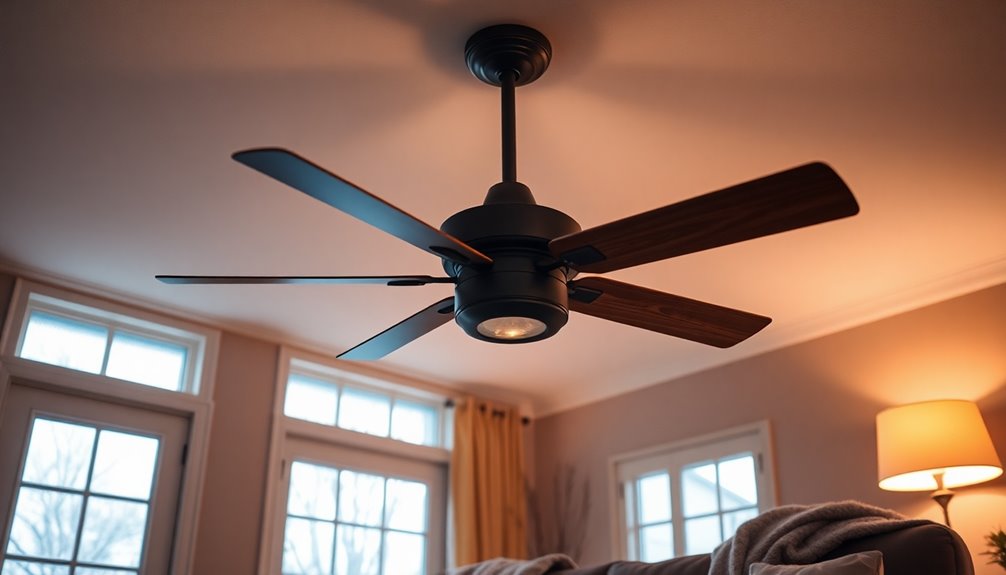
When winter arrives, adjusting your ceiling fan to rotate clockwise can make a noticeable difference in your home's comfort.
This clockwise rotation uses the ceiling fan's reverse function to create an updraft, pushing warm air that collects near the ceiling down into the living space. As the warm air circulates, it helps eliminate temperature stratification, ensuring that the space feels cozy and even without creating uncomfortable downdrafts.
Utilizing your ceiling fan during the colder months can also lead to significant energy savings. By redistributing warm air, you can lower your thermostat settings and reduce your reliance on heating systems, ultimately cutting down on heating costs.
This is especially beneficial in rooms with high ceilings, where warm air tends to linger above occupants.
Ceiling Fan Direction in Summer

In summer, you want your ceiling fan to rotate counterclockwise to create a cooling breeze.
This direction pushes cool air down, enhancing your comfort through a wind-chill effect.
Cooling Effect Explained
Many homeowners mightn't realize that the direction of their ceiling fan plays a crucial role in summer comfort. To achieve the best cooling effect, you should set your ceiling fans to rotate counterclockwise during those hot months. This direction pushes cool air downward, creating an invigorating breeze that can make you feel several degrees cooler without lowering the thermostat.
When your ceiling fan spins counterclockwise, it maximizes airflow and helps prevent that uncomfortable feeling of warm air stagnating around you. This natural wind-chill effect enhances your comfort, allowing you to enjoy your space without cranking up the air conditioning.
Additionally, running your ceiling fan in the correct direction can complement your AC system, leading to greater energy efficiency and potentially reducing your energy costs.
Optimal Rotation Speed
Maximizing comfort during the summer months requires not just the right ceiling fan direction, but also the ideal rotation speed.
When you set your ceiling fan to rotate counterclockwise, it pushes air downward, creating a cooling breeze that enhances your comfort. This counterclockwise rotation generates a wind-chill effect, making a room feel 5 to 10 degrees cooler than it actually is.
For peak performance, it's essential to operate your ceiling fan at a higher speed during the summer.
This guarantees effective air circulation, directing airflow towards you and preventing discomfort from improper airflow. The right rotation speed not only maximizes fan efficiency but also helps reduce your reliance on air conditioning, potentially saving you up to 30% on cooling costs.
Benefits of Seasonal Reversal

When you switch your ceiling fan to reverse in winter, you can enjoy significant energy savings and heightened comfort levels.
The clockwise rotation helps redistribute warm air, making your space feel cozier without cranking up the heat. Not only does this reduce your heating costs, but it also creates a more consistent temperature throughout the room.
Energy Efficiency Gains
Reversing your ceiling fan for the winter months can lead to significant energy efficiency gains, especially when it comes to heating costs.
By redistributing warm air that accumulates near the ceiling, you can save money and enhance your home's overall heating efficiency.
Here are some key benefits:
- Lower heating costs: You can save up to 10% on heating expenses by utilizing your ceiling fan.
- Energy-efficient operation: Ceiling fans use about 60 watts of energy, far less than traditional heating systems.
- Optimized air circulation: The reverse function enables your thermostat to sense warmer air sooner, reducing the run time of your furnace.
- Faster heating: Effective warm air distribution can help heat a room more quickly, making your existing heating systems work more efficiently.
Enhanced Comfort Levels
There's a noticeable difference in comfort levels when you use the reverse function on your ceiling fan during winter months. By setting the fan to rotate clockwise, the blades push warmer air down from the ceiling, creating a cozy environment. This simple adjustment enhances comfort levels markedly, especially in rooms where warm air tends to accumulate near the ceiling.
When you run your ceiling fan on a low speed in reverse mode, it works in harmony with your heating system, helping to circulate the warm air more efficiently. This not only eliminates cold spots but also maintains a consistent temperature throughout the space.
You might even notice a reduction in heating costs—up to 10%—because the fan allows you to rely less on your heating system.
Moreover, improved air circulation means a healthier indoor environment. The fan helps reduce humidity levels and prevents stagnant air, contributing to a more pleasant atmosphere.
Energy Savings From Reversal

By reversing the direction of your ceiling fans during winter months, you can significantly cut down on heating costs.
When you switch to reverse mode, you push the warm air that naturally accumulates near the ceiling down into the living space. This simple adjustment can reduce your heating bills by up to 10%.
Ceiling fans use around 60 watts of energy, making them a cost-effective solution compared to air conditioning units that consume about 3,500 watts.
Here are some key benefits of using ceiling fans in reverse:
- Redistributes warm air evenly, enhancing comfort.
- Helps thermostats detect warmer temperatures sooner.
- Reduces reliance on heating systems, leading to lower energy consumption.
- Lowers overall energy bills by shortening furnace run times.
- Regular maintenance of venting systems ensures efficient operation of heating appliances, complementing the benefits of ceiling fans.
Choosing the Right Ceiling Fan

Selecting the right ceiling fan can enhance your home's comfort and energy efficiency, especially during the colder months when you want to maximize the benefits of reversing your fan's direction.
To find the fan that best suits your needs, start by considering the blade length. Longer blades move cooler air more efficiently at lower speeds, making them ideal for energy savings.
Next, think about the size of the fan. For average bedrooms or kitchens, a 44-inch fan is typically recommended, while larger living areas benefit from fans measuring 50-54 inches.
It's crucial to match the fan size to your room dimensions to achieve the best airflow.
Also, verify the installation height is above 2.20 meters for safety and effectiveness.
Finally, check compatibility with your ceiling type to maximize performance and guarantee safe installation.
Maintenance and Care Tips
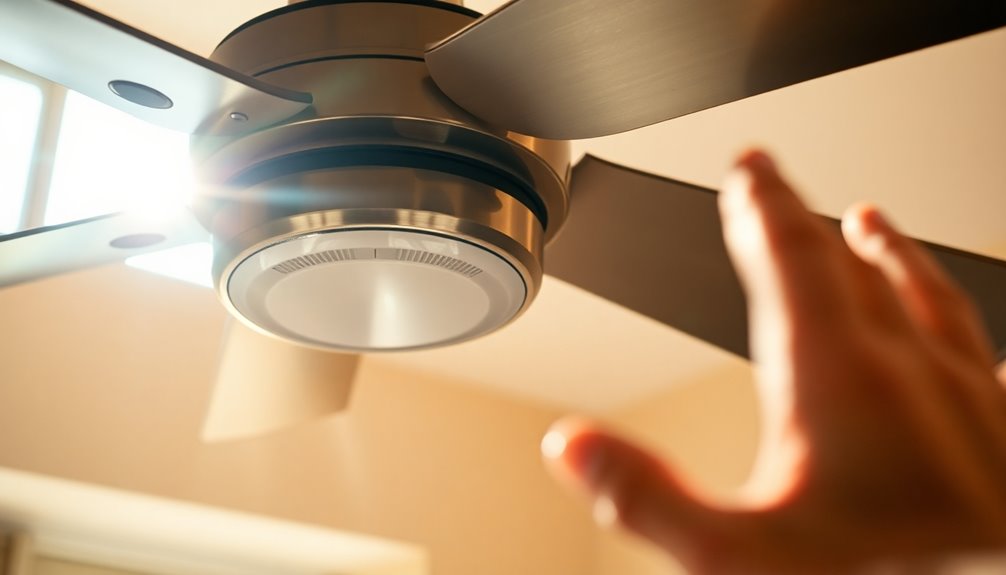
To keep your ceiling fan running smoothly and efficiently, regular maintenance is crucial. A well-maintained fan not only improves airflow but also extends its lifespan, guaranteeing you get the most out of your investment.
Here are some tips to help you with maintenance:
- Clean the blades regularly to remove dust and debris that can hinder performance.
- Check and tighten the mounting hardware and blades to prevent wobbling while the fan is spinning.
- Inspect the motor and electrical connections periodically for any signs of wear or malfunction.
- Change the direction of the fan seasonally to optimize comfort—reverse it for winter warmth and forward for summer cooling.
Additionally, if your fan has an air filter, keep it clean and replace it as needed. This not only enhances air quality but can also improve the efficiency of your air conditioner.
Frequently Asked Questions
Why Would You Reverse a Ceiling Fan?
You'd reverse a ceiling fan to optimize your comfort throughout the year.
In winter, spinning it clockwise pushes warm air down, helping to maintain a cozy atmosphere while potentially lowering your heating costs.
During summer, switching it to counterclockwise creates a revitalizing breeze, which can make the room feel cooler and reduce your reliance on air conditioning.
This simple adjustment enhances your indoor climate and boosts energy efficiency, making your space more comfortable.
What Is the Use of Reverse Rotation in Fans?
The use of reverse rotation in fans lets you optimize comfort throughout the year.
In winter, you can run the fan clockwise to push warm air down, helping to maintain an even temperature and potentially lowering heating costs.
In summer, switching to counterclockwise creates a cooling breeze, enhancing the evaporation effect and making your space feel cooler.
This simple adjustment can greatly improve air circulation and comfort in your home.
Why Do You Need a Reverse Fan?
Did you know you can cut heating costs by up to 10% just by reversing your ceiling fan?
You need a reverse fan because it helps circulate warm air during winter, pushing it down to create a cozy environment. This simple switch enhances comfort and maintains consistent room temperatures.
In summer, it effortlessly creates a cooling breeze.
Which Way Should My Ceiling Fan Spin in the Summer?
In the summer, your ceiling fan should spin counterclockwise. This direction pushes air downwards, creating a cooling breeze that enhances the wind-chill effect.
You'll feel more comfortable without lowering the room temperature. By using your fan this way, you can reduce your reliance on air conditioning and potentially save on energy costs.
Proper airflow is key to keeping the room feeling fresh and preventing the discomfort of stagnant air.
Enjoy your summer!
Conclusion
To sum up, using your ceiling fan's reverse function can make a real difference in your comfort and energy bills. Did you know that properly using ceiling fans in winter can save you up to 15% on heating costs? By switching the fan's direction, you'll create a cozy draft that helps distribute warm air more efficiently. So, don't forget to flip that switch and enjoy both the benefits and savings all year round!



